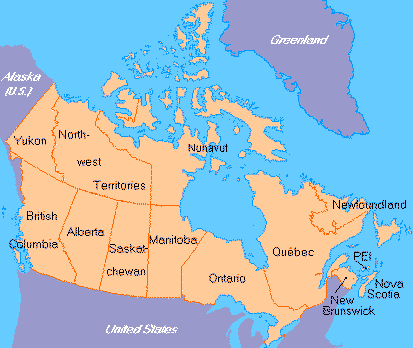Canadian Cuisine and Recipes
Information about Canadian Cooking plus lots of
Canadian Recipes
Â
Cooking
by Country -
September
2006
Scroll
down for Canadian Recipes
Â
Â
Go to:- Canada Featured Ingredient  | Canadian
Speciality Dish  | Cooking by Country Main Page
Â
Â
Situated on the North American continent, Canada
is the second largest country in the world and has land borders with the USA and
Alaska. It has a total coastline measuring 202,080 km on the North Atlantic
Ocean to the east, the North Pacific Ocean on the west and the Arctic Ocean on
the north.
Â

Â
As one might expect of such a large area, the
climate is varied, ranging from temperate in south and West to sub-arctic/arctic
in north. The terrain is mostly plains with mountains in west, prairies in the
centre and lowlands in southeast. There are many rivers and lakes - over 8% of
Canada�s area is covered in water.
Â
Ancient
Times and Influences on Canadian Cooking
Â
Whilst there is a theory that man entered this part of the world some 50,000
years ago by crossing an ice bridge from Siberia to Alaska, a more popular
belief is that migration was a much slower process over thousands of years.
Native Woodland Indians can trace their beginnings back over 3000 years. Most
native peoples at this time were hunter-gatherers. So bountiful was much of this
land at this time � thousands of lakes and rivers teeming with fish, a massive
coastline, rainforests and prairies which supported large herds of buffalo and
wild game - that it wasn�t necessary for them to practice organised farming or
agriculture. Commonly eaten foods included buffalo, beaver, squirrel, elk,
caribou, salmon and other freshwater fish, berries, wild turnips and wild rice
which is one of the few grain native to North America. These peoples were often
semi-nomadic, moving distances to keep pace with the seasons.
An exception to this seems to be the native Indians in the south east of Canada
who, certainly by the time Europeans arrived, were living in fenced villages and
farming corn, beans and squash to supplement their hunting and fishing. However,
even these villages were semi- permanent: every 20 to 40 years, once the land or
hunting became exhausted, they would relocate to another area.
Evidence shows that by 2000 B.C. pottery was being made and cooking techniques
included roasting and boiling and implements made of stone and bone were being
used.
The first contact from Europeans came in the shape of Norsemen around 1000 A.D.
however evidence shows that there was little settlement or influence of
foreigners until the 1400�s with the arrival of the British and French, both of
whom were to have profound influences on the cuisine. By the 1600s France had
settled permanent colonies.
Unlike much of the USA, Canada was not suited to large-scale farming or
plantations. The Europeans� initial interest was fishing, in particular cod,
including the setting up of drying and salting plants and sea mammal hunting, in
particular whaling. The native Inuit�s whaling technology was the most advanced
in the world and together with the colonists� deep sea fishing boats this trade
reached world-wide proportions.
Although the fur trade began as an aside to the fishing industry, it did
eventually reach epic proportions with one almost tragic spin-off food wise: the
Pemmican trade. Pemmican is dried buffalo strips which are mixed with animal fat
(tallow) and berries and has been made by the Native Indians for many years as a
means of preserving their prized buffalo meat. Unfortunately, the amounts made
to accommodate the fur traders contributed greatly to diminishing the bison
population and by the early 1800s plains buffalo had become all but extinct.
Europeans are responsible for having introduced cattle, pigs, chickens and
sheep as well as wheat and potatoes.
Â
Current
Day Canadian Cuisine
Â
Although Canadian cuisine differs slightly from
region to region, it is still a reflection of its early beginnings. For example,
food in Eastern Canada (except for Quebec) and British Columbia the cuisine
sticks to its English, Scottish and Irish roots with salt-cured fish, beef, and
pork being popular. Quebec is all things French �even the language. In Western
Canada, the cuisine tends to be simple and hearty, an echo of the early settlers
who had to make do with local ingredients, and in Northern Canada where the
growing season is shorter, the cuisine is still influenced by the native Inuit
diet including preserved ingredients.
The most recent culinary influences came by way of an influx of recent (1960s)
Asian immigrants from countries such as India, Hong Kong, China and The
Philippines and imported Asian ingredients and cooking methods are becoming more
popular in parts of Canada.
Throughout Canada, maple syrup, which was introduced to the settlers by the
native Indians and products are still very popular.Â
As with the USA, fast food items such as
burgers, fries, hotdogs and doughnuts are popular throughout much of Canada.
Â
Â
Â
|
|